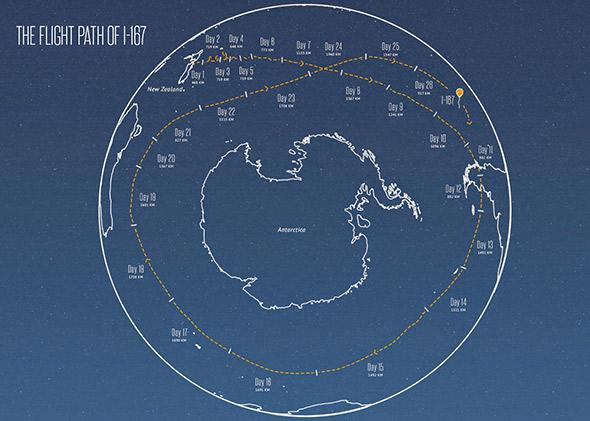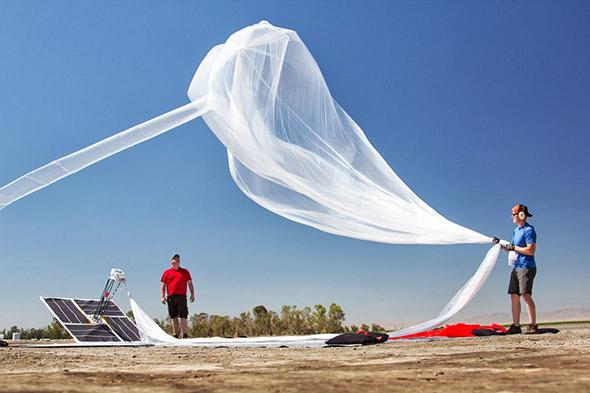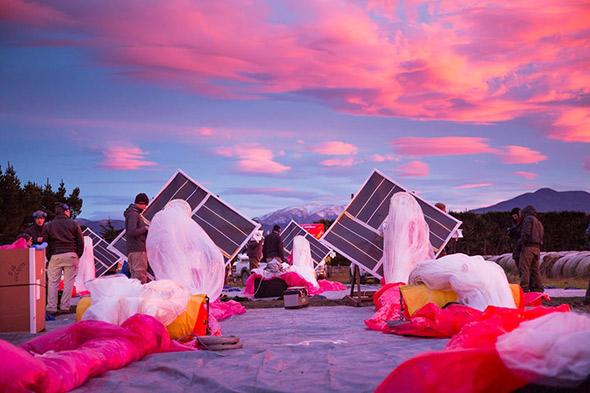The majority of people in the world lack access to the Internet. Either they can’t afford a connection, or none exists where they live. Of all the efforts to bring those people online, Google’s “Project Loon” sounds like the most far-fetched. At the secretive Google X labs, it’s a moonshot among moonshots.
But it just might be working.
When the search company announced in June 2013 that it was building “Wi-Fi balloons” to blanket the world’s poor, remote, and rural regions with Internet beamed down from the skies, expert reaction ranged from skeptical to dismissive—with good reason. The plans called for Google to put hundreds of solar-powered balloons in the air simultaneously, each coordinating its movements in an intricate dance to provide continuous service even as unpredictable, high-speed winds buffeted them about the stratosphere.
“Absolutely impossible,” declared Per Lindstrand, a Swedish aeronautical engineer and perhaps the world’s best-known balloonist, in an early Wired article about the project. “Just talk to anybody in the scientific community.” Specifically, he poked holes in Google’s claim that it could build balloons durable enough to remain aloft for more than 100 days—nearly twice the duration achieved by state-of-the-art NASA balloons. “Even three weeks is very rare,” Lindstrand scoffed.
And yet, as you read this, some 75 Google balloons are airborne, hovering somewhere over the far reaches of the Southern Hemisphere, automatically adjusting their altitudes according to complex algorithms in order to catch wind currents that will keep them on course. By next year, Google believes it will be able to create a continuous, 50-mile-wide ring of Internet service around the globe. And by 2016, Project Loon director Mike Cassidy anticipates the first customers in rural South America, Southern Africa, or Oceania will be able to sign up for cellular LTE service provided by Google balloons. (Google is starting in the far Southern Hemisphere, which is relatively sparsely populated, before expanding elsewhere.)
But wait, I asked him, not wanting to get taken in by the bright-eyed techno-optimism that infuses so much of what Google does these days: What are the chances this will really happen?
“When I first started on this project, I would have said, like, 5 percent,” Cassidy says. “But we’re getting further and further, and what’s amazing is that we haven’t found anything that could keep it from working yet.” Cassidy scans the minimalist conference room at Google’s New York headquarters for some wood to knock on. “You know, nothing in life is 100 percent certain. But it’s looking pretty good.”
How Google has come this far is a study in the power of perseverance—and the power of a company whose resources, leeway, and technological ambitions have few rivals in the annals of global capitalism.
If Lindstrand were there to see the company’s first attempts to launch its super-pressure balloons in New Zealand last summer, he might have laughed. On the first try, the balloon burst not long after liftoff, the nylon fabric overmatched by the 100,000 pounds of pressure within. The same happened on the second try, and the third—and the next 50 after that. The team kept tweaking the fabric and reinforcing it with more Kevlar-like ropes, but the balloons kept bursting until they got the length of the ropes exactly right. (They had to be shorter than the fabric to relieve the pressure, but not too much shorter.)
“We knew it was hard to make a super-pressure balloon,” Cassidy recalls. “We didn’t think it would take us 61 attempts until we succeeded.”
Even then, the success was short-lived. Instead of bursting, the balloon slowly leaked helium, bringing it down after just a day or two in flight. “Even a millimeter-sized hole will bring a balloon like this down in a couple days,” Cassidy says. “And that’s what happened to the next 40 or 50 balloons we made.”

Photo courtesy Google
Google’s engineers spent weeks trying to isolate the problem. They took balloons out of their boxes and inflated them in a cavernous hangar at Moffett Field in Mountain View, shined polarized light through them, and even sniffed for helium leaks using a mass spectrometer. Each balloon that went down was subjected to a “failure analysis” that included poring over meticulous records of who had assembled it, where, and using what equipment, and how it had been transported.
Eventually they pinned the leaks on two sets of problems. One was that the balloons had to be folded several times over to be transported, and some developed tiny tears at the corners where they’d been folded repeatedly. Google set to work finding ways to fold and roll the balloons that would distribute the stress more evenly across the fabric.
The second problem was that some balloons were ripping slightly when workers stepped on the fabric with their socks. The solution to that problem? “Fluffier socks,” says Cassidy. “Seriously, that made a difference. Softer socks meant fewer leaks.”
As the team cut down on the leaks, the balloons started lasting longer: four days, then six, then several weeks at a time. As of November, Cassidy says, two out of every three balloons remain in the sky for at least 100 days.
But keeping the balloons airborne is only the first of the monumental problems that the project presented. Keeping them on course may be even harder.
When Google first announced the project, I pictured brightly colored vessels hovering in place a few hundred or thousand feet over their respective target villages, perhaps tethered to the world’s longest ropes. The reality is far more complex—and fascinating.
First of all, the balloons rise more than 60,000 feet above the Earth’s surface, putting them far beyond the reach of the highest-flying planes—and atmospheric storm systems. That’s much too high to be visible from the ground.
Secondly, the balloons could never hover in place. They’re constantly propelled by stratospheric wind currents that can reach up to 100 mph. That’s a little problematic, given that the aim is to provide steady data service to stationary targets back on solid ground. Google’s solution is to keep large fleets of balloons aloft at all times, with some following in others’ wakes. That way, just as one balloon is about to drift out of range of a given location, the next one is entering the zone, keeping the connection alive.

Photo courtesy Andrea Swenson Dunlap/Google
That would be a tricky enough ballet with high-powered aircraft that could steer themselves along precise paths. But again, these are low-powered balloons, and there’s no way to directly control their trajectory. All you can do is adjust their altitude. “Steering,” then, involves projecting the wind speeds and directions at different altitudes, and maneuvering the balloons up and down in hopes of catching a succession of currents that will approximate the path you’re aiming for.
Google’s engineers knew that would be difficult going in, and they planned to rely on wind velocity data from the National Weather Service’s weather balloons and archival records. What they didn’t anticipate was just how unpredictable those wind currents can be. For example, the NWS might report that the wind at 55,000 feet is blowing south at 20 mph, while the wind at 65,000 feet is blowing southeast at 30 mph. Using linear interpolation, Google figured that the wind at 60,000 feet would be blowing south-southeast at 25 mph. Sometimes that was right. Other times, however, the team would find that the wind at 60,000 feet was blowing the opposite direction entirely. So much for its algorithms.

Photo courtesy Google
An embarrassing example of that problem came when Google was performing a high-profile demonstration of its balloons in Brazil in May, in front of the country’s communications minister and the president of Telefonica. “You know how they say, ‘Never do a live demo?’ ” Cassidy says. “The first balloon went up and we told them, ‘Look, our simulations show that the balloon’s going to go this way.’ Everybody looked—and the balloon went the other way.” Google’s red-faced project leaders quickly ordered the wayward balloon brought down and dispatched a truck to retrieve it, some 12 miles away. They sent up a second balloon, and this time the winds cooperated. Students at a local school successfully logged on.
It seems clear that Google has the potential to deliver on its promise of bringing at least some form of Internet access to regions that have been without it. Whether it proves to be worth all the effort will depend on how fast and reliable that service is and how much it costs to keep it going.
The original idea was to broadcast Wi-Fi from the balloons to base stations on the ground. But Google quickly realized that the power limitations outweighed the advantages of the unregulated spectrum. Instead, the company began to partner with telecommunications companies to broaden their existing cellular networks using the same LTE protocol. Essentially, the balloons use a low-cost, low-power version of the same type of LTE node that sits atop a standard cell tower. Google says it can now deliver data at 5 megabits per second to mobile phones, or a zippy 22 Mbps to fixed antennas. For comparison, the average broadband speed in the United States today is about 11 Mbps.
By contracting with telecoms to provide the service, Google removes itself from the sales and customer-service end of the cellular-data equation, and from the country-by-country battle for rights to the 2.6 GHz spectrum. The company is famously far more interested in solving complex engineering problems than it is in dealing directly with consumers or lobbying bureaucratic agencies.

Photo courtesy Andrea Swenson Dunlap/Google
Providing Internet via a fleet of algorithmically directed balloons might sound prohibitively expensive, but Cassidy says it’s actually an order of magnitude cheaper than setting up and maintaining cell towers, making it more economically viable in remote regions. And while the quality of service you’ll get from overhead balloons will never match that of, say, Google Fiber, Cassidy is convinced the company can make it a vast improvement over what many parts of the world have today. “We’ve visited villages where people get their Internet from a Wi-Fi hotspot on an inter-city bus,” he says. “As the bus rolls in, everybody’s phone suddenly will download its messages. And the bus will drive to the next village and suddenly it’ll be a hotspot for those people.”
If Project Loon succeeds, Google’s project will soon face a new set of questions—one that its doubters never thought it would have to ask. Questions like: Will it be profitable? And: Should countries trust Google with their stratospheric airspace? In a June follow-up with Wired, Google X chief Astro Teller called Project Loon “the poster child for Google X.” The team has done a remarkable job so far harnessing the 100,000 pounds of pressure inside each balloon. The next test will be how it handles the pressure of turning a moonshot into a business.
This article is part of Future Tense, a collaboration among Arizona State University, New America, and Slate. Future Tense explores the ways emerging technologies affect society, policy, and culture. To read more, visit the Future Tense blog and the Future Tense home page. You can also follow us on Twitter.
